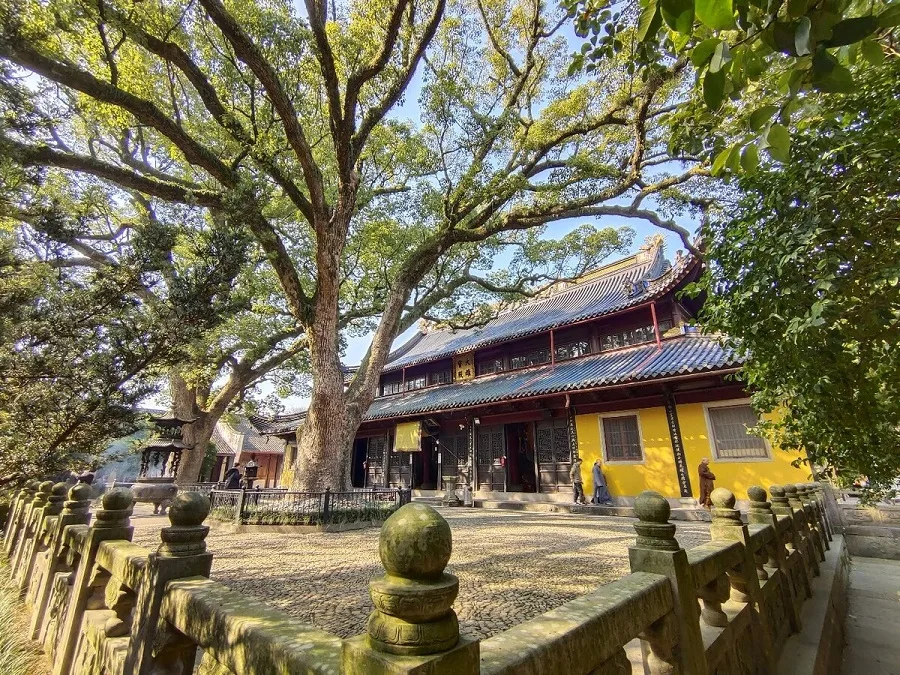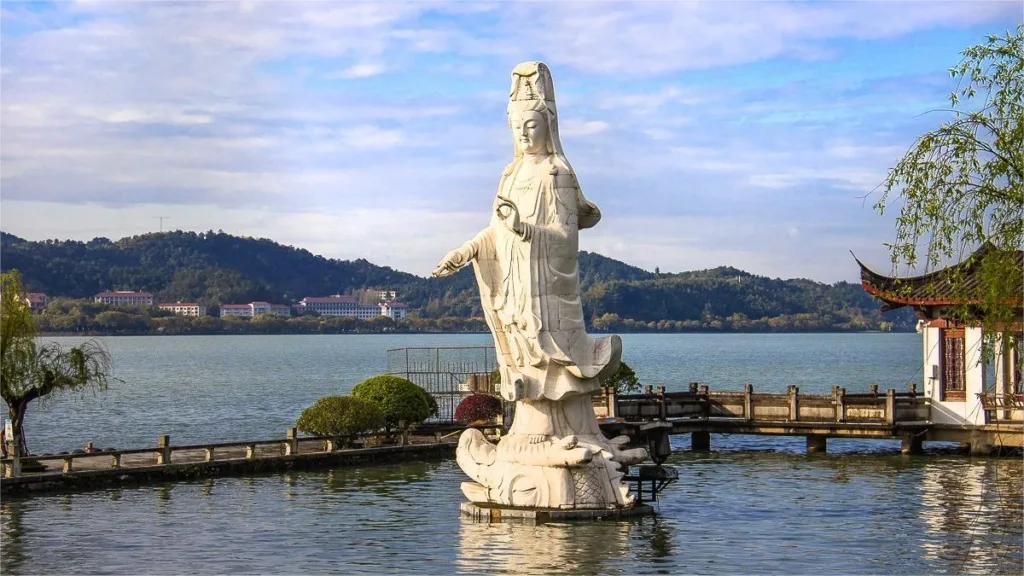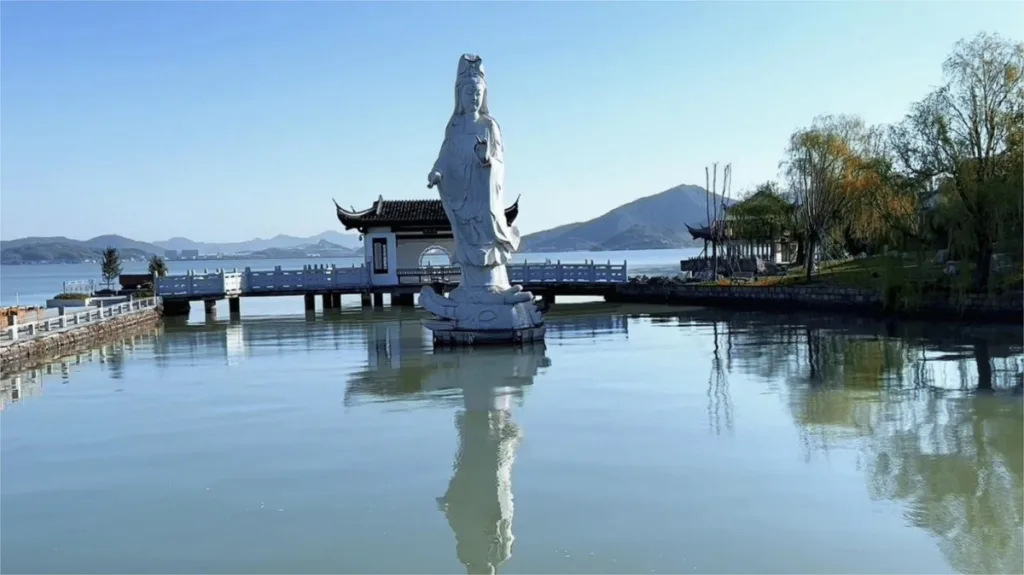The Ashoka Temple in Ningbo City (宁波阿育王寺, Ayuwang Temple) traces its roots back to the third year of the Tai Kang reign during the Western Jin Dynasty in 282 AD, boasting over 1700 years of history. Revered as the “Buddhist Kingdom of the Southeast,” it stands as a renowned monastery of the Zen Buddhist tradition, uniquely named after the Indian Emperor Ashoka, making it the only millennium-old temple in China to bear his name. The temple is celebrated both domestically and internationally for housing the relics of the Buddha Shakyamuni and its exquisitely crafted pagoda containing these sacred relics. Covering an area of 124,100 square meters, with a built-up area of 23,400 square meters, the Ashoka Temple comprises over 600 halls, pavilions, and towers, harmoniously nestled along the slopes of the landscape. It has meticulously preserved a plethora of historical artifacts, including steles, stone carvings, inscribed plaques, and ancient scriptures, offering visitors a glimpse into its rich heritage and cultural significance.
According to historical records, in 282 AD, a man named Liu Sa, from Bingzhou, fell gravely ill and dreamt of a Brahmin monk indicating salvation. Upon his recovery, he renounced worldly life, adopting the name Huida, and followed the guidance of his dream, embarking on a quest for a sacred pagoda. Arriving at Mount Weishan in Wushi’ao, he heard resounding bell chimes emanating from the ground below. Deeply moved, he devoted himself to prayer and scripture recitation for three days and nights. Miraculously, a pagoda emerged from the earth, adorned with sacred relics on each of its five tiers. Huida then took up residence in a thatched hut at this site, dedicating himself to the pursuit of spiritual enlightenment. Thus began the illustrious history of the Ashoka Temple.
Table of Contents
- Basic Information
- Location and Transportation
- Highlights of Ashoka Temple
- Vlog about Ashoka Temple
- Attractions near Ashoka Temple
Basic Information
| Estimated Length of Tour | 2 – 3 hours |
| Ticket Price | Free |
| Opening Hours | 7.00 – 16.00 |
| Telephone Number | 0086-0574-88383421 |
Location and Transportation
Located at the foot of the Huading Peak in the Taibai Mountain of Wuxiang Town, Yinzhou District, Ningbo City, Zhejiang Province, the Ashoka Temple is nestled within the serene surroundings of nature. To get there, you can choose one of the following ways:
Bus: Take bus 107-1, 155, 162, or 750, get off at Yuwang Stop (育王站), and wak about 500 meters to the northeast to reach the temple.
Metro: The closest metro station to Ashoka Temple is Baozhuang (宝幢) on line 1. After getting out of the station from Exit A, walk about 1.1 kilometers to the northeast to reach the temple.
Highlights of Ashoka Temple
Mahavira Hall (Daxiong Baodian)

The Mahavira Hall, also known as Daxiong Baodian, is a majestic structure spanning seven bays wide with a double-eaved gable roof adorned with black tiles. Standing at approximately fourteen meters tall, the roof ridge is embellished with colorful sculptures depicting auspicious symbols like the dragon playing with a pearl, symbolizing good fortune and prosperity. Inscribed on the lower eaves of the hall, you’ll find the phrase “觉行俱圆,” meaning “Awakening and Fulfilling Together,” calligraphed by Emperor Qianlong of the Qing Dynasty. Inside the hall, above the entrance, hangs a horizontal plaque inscribed with the words “善狮子吼,” meaning “The Good Lion Roars,” also penned by Emperor Qianlong. Enshrined within the hall are statues of Shakyamuni Buddha in the center, flanked by the Medicine Buddha and his disciple Ananda on the east, while the west side houses Amitabha Buddha and the disciple Kashyapa. Adorning the sides of the hall are statues of the Eighteen Arhats, and behind them, you’ll find depictions of the Fifty-Three Visits of Sudhana, along with statues of Manjushri Bodhisattva and Samantabhadra Bodhisattva. Two camphor trees stand tall in front of the hall, towering over its roofline, adding to the serene ambiance.
Buddha Relics Hall (Sheli Dian)

The Buddha Relics Hall, also known as Sheli Dian, boasts a width of five bays and features a double-eaved gable roof adorned with yellow glazed tiles. Its height reaches approximately thirteen meters. The exquisite screen doors at the front entrance are intricately carved, adding to the hall’s splendor. Inscribed on a square plaque above the eaves is the phrase “妙胜之殿,” meaning “The Hall of Wonderful Victory,” commissioned by Emperor Xiaozong of the Song Dynasty. Inside the hall, a vertical plaque hangs from the beam in the center, bearing the inscription “佛顶光明之塔,” meaning “The Pagoda of Buddha’s Light,” calligraphed by Emperor Gaozong of the Song Dynasty. A horizontal plaque reading “光明庄严” hangs on the southern side. At the center of the hall stands a seven-meter-tall stone stupa, housing a niche adorned with seven treasures containing sacred relics. Below the stupa, you’ll find statues of the Four Heavenly Kings and King Ashoka. Behind the stone stupa lies a reclining statue of Shakyamuni Buddha, measuring approximately four meters in length. Flanking the sides of the hall’s front terrace are four precious steles, including the Tang Dynasty’s “Permanent Field Stele of Ashoka Temple 阿育王寺常住田碑,” authored by Wanzhai Rong, and the Song Dynasty’s “Inscription of Miao Xi Quan 妙喜泉铭,” composed by Zhang Jiucheng. The rear of the hall features the “Mother’s Milk Spring,” with the inscription “San Mantuo Hua 散曼陀华” carved above it, calligraphed by the Qing Dynasty calligrapher Gao Zhenxiao.
The Relic Pagoda

The Relic Pagoda is dedicated to housing the revered relic of Shakyamuni Buddha, known far and wide. It is a square-shaped bronze casket pagoda, standing at approximately 0.4 meters tall, with a precious gemstone, the size of a green bean, suspended by silver threads within a small window opening. However, the relic itself is rarely visible to regular visitors as viewing it requires prior permission. The stone pagoda that encases the relic pagoda dates back to the Ming Dynasty and stands at 4 meters tall with a width of 1.5 meters on each side. It follows the Indian style of a single-story square casket pagoda, adorned with jewels and corner ornaments, featuring images of Shakyamuni Buddha attaining enlightenment and the eight kings dividing relics, intricately carved and gilded throughout.
The East Pagoda of Ashoka Temple

The exact date of the construction of the East Pagoda is unknown, but it was depicted in the painting “Yukio Kosai Sanso Zu” by the Japanese painting master Sesshu during the Ming Dynasty. The current pagoda was rebuilt in 1995. Since the tenure of the abbot Tongyi, efforts have been made to propagate Buddhism and restore the ancient traditions of the temple. Despite the gradual restoration of ancient halls and the expansion and renovation of the temple buildings, it was deemed insufficient in fulfilling the merits. Inspired by the “Three Pagodas of Ashoka” painting by the Japanese monk Sesshu during the Ming Chenghua period, a new pagoda was erected on the east side of the temple. With a fundraising effort of over 5.5 million yuan and the contribution of more than 20,000 workers, the construction spanned four years and was successfully completed in 1995. Positioned to the east of the temple, it is nearly symmetrical to the lower pagoda built on the west side of the temple, hence referred to as the East Pagoda. According to local beliefs, circling the pagoda clockwise can wash away misfortunes.




